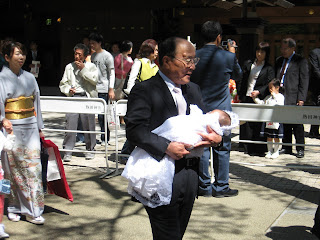

Following up on last weekend’s trip to the most sacred shrine in Japan in Ise, I went to Atsuta-jingu, Japan's second most sacred shrine. It dates from the 3rd century, and looks a lot like the shrines at Ise.




I don’t know if it was some sort of special day, but there were at least two weddings happening there that day, as well as some sort of ceremony for new babies. I quickly lost count of how many very young babies I saw in what looked like a christening gown, and blanketed with what seemed to be a small kimono cover. I assume the families were praying for the baby’s health and success, much like they do in November for the 7-5-3 holiday for children aged 7, 5, and 3.
(The groom is in the black kimono. In the red and white outfits are the shrine priests and priestesses).




After the shrine, I headed to Nagoya castle. The castle was very nice, had lots of good displays inside it, and a nice garden around it.

The wisteria was in bloom, and there were many rest areas with benches under the wisteria.

The symbols of the castle are the golden shachi on the roof. These shachi are usually translated as dolphins, but recently someone told me they are actually supposed to be orca whales. However, the shachi have scales and don’t resemble orcas any more than they resemble dolphins. I like the explanation that it is a mythical creature, a fish with a tiger’s head, best. Shachi are often on top of buildings are protection against fire (apparently if a fire were to happen, the shachi would magically spout water and put out the fire). The shachi on top of Nagoya castle are a pair – one male and one female. The female is the tiniest bit smaller than the male. An exhibit in the museum explained how in difficult economic times, the shachi were melted down and recreated using less gold.



Like much else in Japan, the castle was destroyed in WWII and rebuilt. Interestingly, in the museum inside the castle, they had a photo of the castle engulfed in flames from the air raids.
Some of the stones in the castle foundation and walls had been etched with symbols to indicate which feudal lord placed the stone. Apparently this was so no one could later take credit for another’s work, or be accused of not contributing their share of the work.

Kiyomasa Kato takes credit for this large stone.

A lot of ex-pats live in Nagoya, so there were a lot more signs in English than is typical. However, even the English in Nagoya could use a little work.







No comments:
Post a Comment